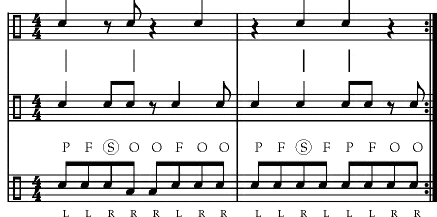CLAVE CONCEPTS: Afro-Cuban Rhythms
In order to understand Afro-Cuban rhythms one
must pursue an extensive study of the clave role and its relationship
with the instruments, compositions and arrangements. For it is the clave rhythm
that provides the foundation in this style of music.
There are two major clave styles in Afro-Cuban music, the son clave and the rumba clave. They
are both two bar rhythms, consisting of a bar containing three notes and
another containing two. These rhythms can be approached two ways.
In the 3-2 often refer to as the 'forward clave' and in the 2-3
refer to as 'reverse clave'. The choice of the direction of
the clave rhythm is guided by the melody, which in turn directs
all other instruments and arrangements. In many contemporary compositions
such as the ones recorded by Fania All Stars, Mongo Santamaria and Ruben
Blades, arrangers make use of both directions of the clave in different
sections of the tunes. As far as the type of clave rhythm
used, it depends on the style. Generally son clave is associated
with dance styles, while rumba clave is associated with folkloric
rhythms.
The following shows both styles in the 3-2 variety. You will discover that the difference lies on the fourth beat of the first
bar. In the son clave its on beat 'four', while in the rumba
clave its on the 'and of four'. You should practice these rhythms
clapping, while tapping quarter notes with your foot that is beats 'one,
two, three and four' then by tapping half notes with your foot that is
beats 'one and three'.
3-2 Son Clave

3-2 Rumba Clave

In the following example you will find the origins
of the clave rhythm. In Cuba the clave pattern developed
from various 6/8 rhythms found in sacred and secular African music. Again practice by clapping the rhythm while tapping your foot, this time
tapping dotted quarter notes that is beats 'one and four'.

The following example illustrates 3-2 son clave and its relationship with two other percussion instruments; timbales and congas. First you will find the rhythm played on the cascara or shell of the small timbal for which I have marked clear points of connection,
and second the basic conga rhythm known as tumbao, which features
open tones on the low drum on the 'three side' of the clave.
Claves
Cascara
Congas
|
 |
After practicing all the examples as written you
should reverse them and approached all the rhythms in the 2-3 variety.
© Alex Pertout. All rights reserved. No part of this article
may be reproduced without prior written permission from the author. This article was first published in Drumscene magazine.
|




